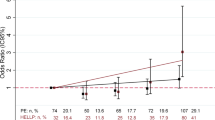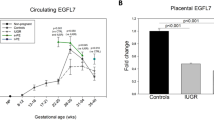Abstract
Early onset eclampsia has significant morbidity and mortality for both the mother and fetus. No effective treatment exists at present except delivery and seizure prophylaxis with magnesium sulfate. We report the novel use of a fragmented ovine antibody against digoxin for the treatment of eclampsia. A 16-year-old primagravida at 29 weeks 5/7 days gestation presented with clinical diagnosis of eclampsia and was treated with compassionate off-label use of digoxin-fragmented ovine antibody (Digibind Glaxo Smith Kline, Research Triangle Park, NC, USA). Improvement of her underlying disorder during a 48 h treatment window was noted without adverse maternal or neonatal outcome. We suggest digoxin-fragmented ovine antibody as a possible intervention in preterm pregnancies complicated by pre-eclampsia or eclampsia.
This is a preview of subscription content, access via your institution
Access options
Subscribe to this journal
Receive 12 print issues and online access
$259.00 per year
only $21.58 per issue
Buy this article
- Purchase on Springer Link
- Instant access to full article PDF
Prices may be subject to local taxes which are calculated during checkout


Similar content being viewed by others
References
Diagnosis and Management of Preeclampsia and Eclampsia. American College of Obstetricians and Gynecologists 2008 Compendium of selected publications: Washington DC, ACOG Practice Bulletin #33, January 2002, pp 717–725.
Cunningham FG, Leveno KJ, Bloom SL, Hauth JC, Gilstrap LC, Wenstrom KD . Hypertensive Disorders in Pregnancy, Williams Obstetrics, 22 ed, McGraw-Hill, New York, 2005, pp 761–808.
Sibai BM . Diagnosis, prevention, and management of eclampsia. Obstet Gynecol 2005; 105: 402–410.
NIH Consensus Development Conference Reaffirms Single Course of Antenatal Corticosteroids for Preterm Women. Cites Insufficient Evidence for Repeat Courses. NIH News Release 18 August 2000. http://consensus.nih.gov.
Sibai BM, Akl S, Fairlie F, Moretti M . A protocol for managing severe preeclampsia in the second trimester. Am J Obstet Gynecol 1990; 163: 733–738.
Sibai BM, Mercer BM, Schiff E, Friedman SA . Aggressive versus expectant management of severe preeclampsia at 28–32 weeks' gestation: a randomized controlled trial. Am J Obstet Gynecol 1994; 171: 818–822.
Odendaal HJ, Pattinson RC, Bam R, Grove D, Kotze TJ . Aggressive or expectant management for patients with severe preeclampsia between 28–34 weeks' gestation: a randomized controlled trial. Obstet Gynecol 1990; 76: 1070–1075.
Haddad B, Deis S, Goffinet F, Paniel BJ, Cabrol D, Sibai BM . Maternal and perinatal outcomes during expectant management of 239 severe preeclamptic women between 24 and 33 weeks' gestation. Am J Obstet Gynecol 2004; 190: 1590–1597.
Goodlin RC . Antidigoxin antibodies in eclampsia. N Engl J Med 1988; 318: 518–519.
Adair CD, Buckalew VM, Taylor K, Ernest JM, Frye AH, Evans C et al. Elevated endoxin-like factor complicating a multifetal second trimester pregnancy: treatment with digoxin-binding immunoglobulin. Am J Nephrol 1996; 16: 529–531.
Gilson GJ, Graves SW, Qualls CR, Curet LB . Digoxin-like immunoreactive substance and sodium-potassium-adenosine triphosphatase inhibition in normal pregnancy: a longitudinal study. Obstet Gynecol 1997; 89: 743–746.
Balzan S, Montali U, Genovesi-Ebert A, Biver P, Fantoni M, Ghione S . Comparison between endogenous digoxin-like immunoreactivity and 86RB+ uptake by erythrocytes in extracts of human plasma. Clin Sci 1989; 77: 375–381.
Garzetti GG, Tranquilli AL, Cugini AM, Mazzanti L, Cester N, Romanini C . Altered lipid composition, increased lipid peroxidation, and altered fluidity of the membrane as evidence of platelet damage in preeclampsia. Obstet Gynecol 1993; 81: 337–340.
Gusdon JP, Buckalew VM, Hennessy JF . A digoxin-like immunoreactive substance in preeclampsia. Am J Obstet Gynecol 1984; 150: 83–85.
Beyer AD, Odendaal HJ, Spruyt LL, Parkin DP . The possible role of endogenous digitalis-like substance in the causation of preeclampsia. SA Mediese Tydskrif 1984; 65: 883–885.
Kaminski K, Rechberger T . Concentration of digoxin-like immunoreactive substance in patients with preeclampsia and its relation to severity of pregnancy-induced hypertension. Am J Obstet Gynecol 1991; 165: 773–776.
Graves SW . Sodium regulation, sodium pump function and sodium pump inhibitors in uncomplicated pregnancy and preeclampsia. Front Biosci 2007; 12: 2438–2446.
Poston L . Sodium transport inhibitors in pregnancy-inducted hypertension. Cardiovasc Drugs Ther 1990; 4 (Suppl 2): 351–356.
Author information
Authors and Affiliations
Corresponding author
Rights and permissions
About this article
Cite this article
Adair, C., Buckalew, V., Kipikasa, J. et al. Repeated dosing of digoxin-fragmented antibody in preterm eclampsia. J Perinatol 29, 163–165 (2009). https://doi.org/10.1038/jp.2008.181
Received:
Revised:
Accepted:
Published:
Issue Date:
DOI: https://doi.org/10.1038/jp.2008.181



